Study on Electrical Characteristics and ECG Signal Acquisition Performance of Fabric Electrodes Based on Organizational Structure and Wearing Pressure
Abstract
1. Introduction
2. Experiment
2.1. Materials and Instruments
2.2. Design and Manufacture of Fabric Electrode Organization Structure
- (1)
- (2)
- (3)
2.3. Testing and Characterization
2.3.1. Surface Resistance Test Between Conductive Fabric and Copper Plate
2.3.2. Impedance Test of Contact Between Fabric Electrode and Skin
2.3.3. Collection of Static and Dynamic ECG
3. Results and Discussion
3.1. Analysis of Surface Resistance Between Conductive Fabric and Copper Plate
3.2. Analysis of the Impedance of the Contact Between the Fabric Electrode and the Skin
The Influence of Tissue Structure on the Impedance of the Contact Between the Fabric Electrode and the Skin
3.3. Quality Analysis of Static and Dynamic ECG
3.3.1. Analysis of the Quality Results of Static ECG Collected by Fabric Electrodes
3.3.2. Quality Analysis of Dynamic ECG Collected by Fabric Electrodes Under Different Wear Pressures
3.3.3. Quality Analysis of Dynamic ECG Collected by Electrodes of Different Tissue Structures Under the Same Wearing Pressure
4. Conclusions
- (a)
- The contact impedance between electrodes of the same organizational structure and the skin decreased with increasing wearing pressure. Satin and twill structure electrodes had lower contact resistance with the skin than plain fabric electrodes, and their impedance curves changed more smoothly.
- (b)
- The organizational structure and the wearing pressure of the fabric electrodes had little effect on the quality of the ECG under rest. Dynamical ECG signals acquired at larger wearing pressures were better than those at smaller pressures. The best ECG signals were acquired by the satin structure electrodes compared to the other two structure fabric electrodes.
- (c)
- Combined with the pressure range of human comfortable clothing, it was concluded that the fabric electrodes prepared with the satin structure can collect dynamic and static ECG signals with stable quality. The satin-structure fabric electrodes simultaneously provided good comfort wearing in the pressure range of 3–4 kPa.
Author Contributions
Funding
Data Availability Statement
Conflicts of Interest
References
- Liu, C.Y.; Yang, M.C.; Di, J.A. Wearable ECG: Development history, Core Technology and Future Challenges. Chin. J. Biomed. Eng. 2019, 38, 641–652. [Google Scholar]
- Lin, S.; Zhu, J.J. Wearable ECG monitoring system based on fabric electrodes. J. Sens. Technol. 2017, 30, 944–949. [Google Scholar]
- Wen, D.W.; Yang, K. Research progress of fabric electrodes for ECG detection. Text. Her. 2018, 3, 72–75. [Google Scholar]
- Xiao, X.L.; Dong, K.; He, W.T. Research progress on fabric electrodes in wearable electronic clothing. J. Cloth. 2017, 2, 1–6. [Google Scholar] [CrossRef]
- Zhou, W.; Tian, Z.; Chen, X.X. The current situation and prospects of wearable medical health monitoring. Chin. Med. Equip. 2017, 32, 1–5. [Google Scholar]
- Song, J.Z.; Yan, H.; Gong, G.Q. Research progress on fabric electrode technology for ECG signal acquisition. Sens. Microsyst. 2015, 34, 4–7. [Google Scholar]
- Zhang, L.; Liu, Q.; Zeng, W.C. Research progress on fabric electrodes for ECG monitoring. Cotton Text. Technol. 2021, 49, 80–84. [Google Scholar]
- Meng, Y.; Zheng, G.; Dai, M. Research on wearable ECG signal acquisition electrodes. J. Tianjin Univ. Technol. 2014, 30, 22–25. [Google Scholar]
- Xu, P. Analysis of the Mechanical Action Between the Textile Structure Electrode and the Skin Used for Surface ECG Monitoring and Dynamic Noise Research. Master’s Thesis, Donghua University, Shanghai, China, 2012. [Google Scholar]
- Kusche, R.; Kaufmann, S.; Ryschka, M. Dry electrodes for bioimpedance measurements—Design, characterization and comparison. Biomed. Phys. Eng. Express 2018, 5, 015001. [Google Scholar] [CrossRef]
- Taji, B.; Chan, A.D.; Shirmohammadi, S. Effect of pressure on skin-electrode impedance in wearable biomedical measurement devices. IEEE Trans. Instrum. Meas. 2018, 67, 1900–1912. [Google Scholar] [CrossRef]
- Jia, G.; Zeng, C.; Fan, L. Effect of electrode pressure change on the resistance of knitted fabrics. Text. Her. 2014, 12, 90–92. [Google Scholar]
- Dong, K.; Zhang, L.; Fan, J. Analysis of the mechanism of ECG signal monitoring and wearable pressure by fabric electrodes. J. Text. 2019, 40, 75–82. [Google Scholar]
- Chansaengsri, K.; Tunhoo, B.; Onlaor, K.; Thiwawong, T. Preparation of conductive screen-printing ink for high-performance bendable and wearable ECG electrodes on fabric substrates. IEEE Sens. J. 2022, 22, 23683–23691. [Google Scholar] [CrossRef]
- Nigusse, A.B.; Mengistie, D.A.; Malengier, B. Wearable smart textiles for long-term electrocardiography monitoring—A review. Sensors 2021, 21, 4174. [Google Scholar] [CrossRef] [PubMed]
- Song, X.; Feng, X. The relationship between clothing pressure and human comfort. J. Text. 2006, 27, 103–105. [Google Scholar]
- Zhan, H.; Xu, J. Research and application of pressure comfort of clothing. Beijing Text. 2004, 25, 58–60. [Google Scholar]
- Yin, L.; Zhang, W. Research review and analysis of the pressure comfort of clothing. J. Text. 2008, 29, 137–142. [Google Scholar]
- Beckmann, L.; Neuhaus, C.; Medrano, G. Characterization of textile electrodes and conductors using standardized measurement setups. Physiol. Meas. 2010, 31, 233–247. [Google Scholar] [CrossRef] [PubMed]
- Zhang, M.; Guo, N.; Gao, Q.; Li, H.; Wang, Z. Design, characterization, and performance of woven fabric electrodes for electrocardiogram signal monitoring. Sensors 2022, 22, 5472. [Google Scholar] [CrossRef] [PubMed]
- Wen, D.W. Design and Research of Fabric Electrodes for ECG Monitoring. Master’s Thesis, Tianjin University of Technology, Tianjin, China, 2018. [Google Scholar]
- Sundarsingh, E.F.; Sreeja, B.S.; Shankararajan, R. Performance analysis of wearable pressure sensor based on structural properties of zinc oxide nanostructures grown on fabric. IEEE Trans. Nanotechnol. 2021, 20, 837–845. [Google Scholar] [CrossRef]
- Kim, Y.; Park, J.B.; Kwon, Y.J.; Hong, J.Y.; Jeon, Y.P.; Lee, J.U. Fabrication of highly conductive graphene/textile hybrid electrodes via hot pressing and their application as piezoresistive pressure sensors. J. Mater. Chem. C 2022, 10, 9364–9376. [Google Scholar] [CrossRef]
- Wu, W.; Pirbhulal, S.; Sangaiah, A.K.; Mukhopadhyay, S.C.; Li, G. Optimization of signal quality over comfortability of textile electrodes for ECG monitoring in fog computing based medical applications. Future Gener. Comput. Syst. 2018, 86, 515–526. [Google Scholar] [CrossRef]
- Jing, M.L. Fabric Structure and Design; China Textile & Apparel Press Co., Ltd.: Beijing, China, 2021. [Google Scholar]
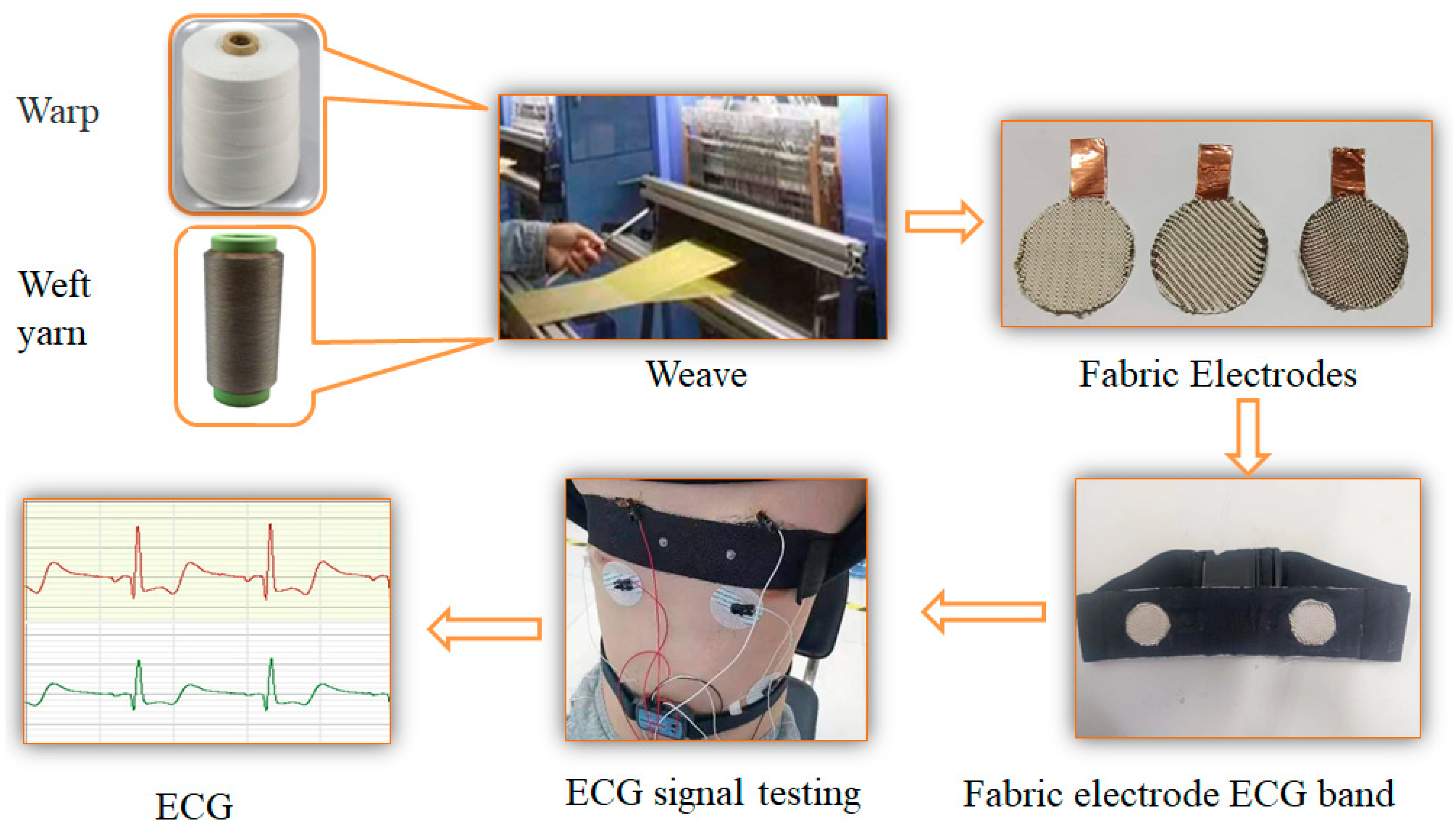


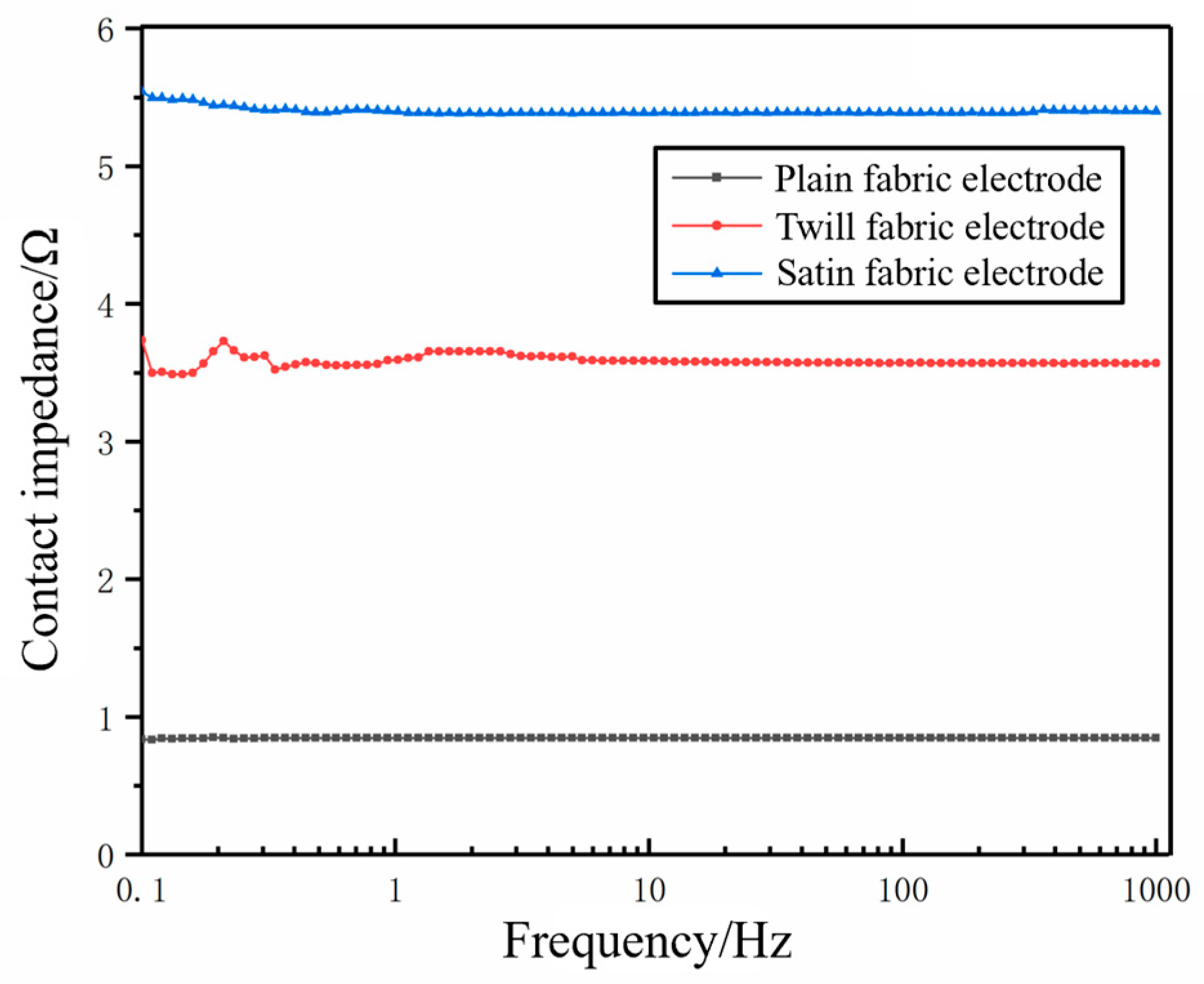




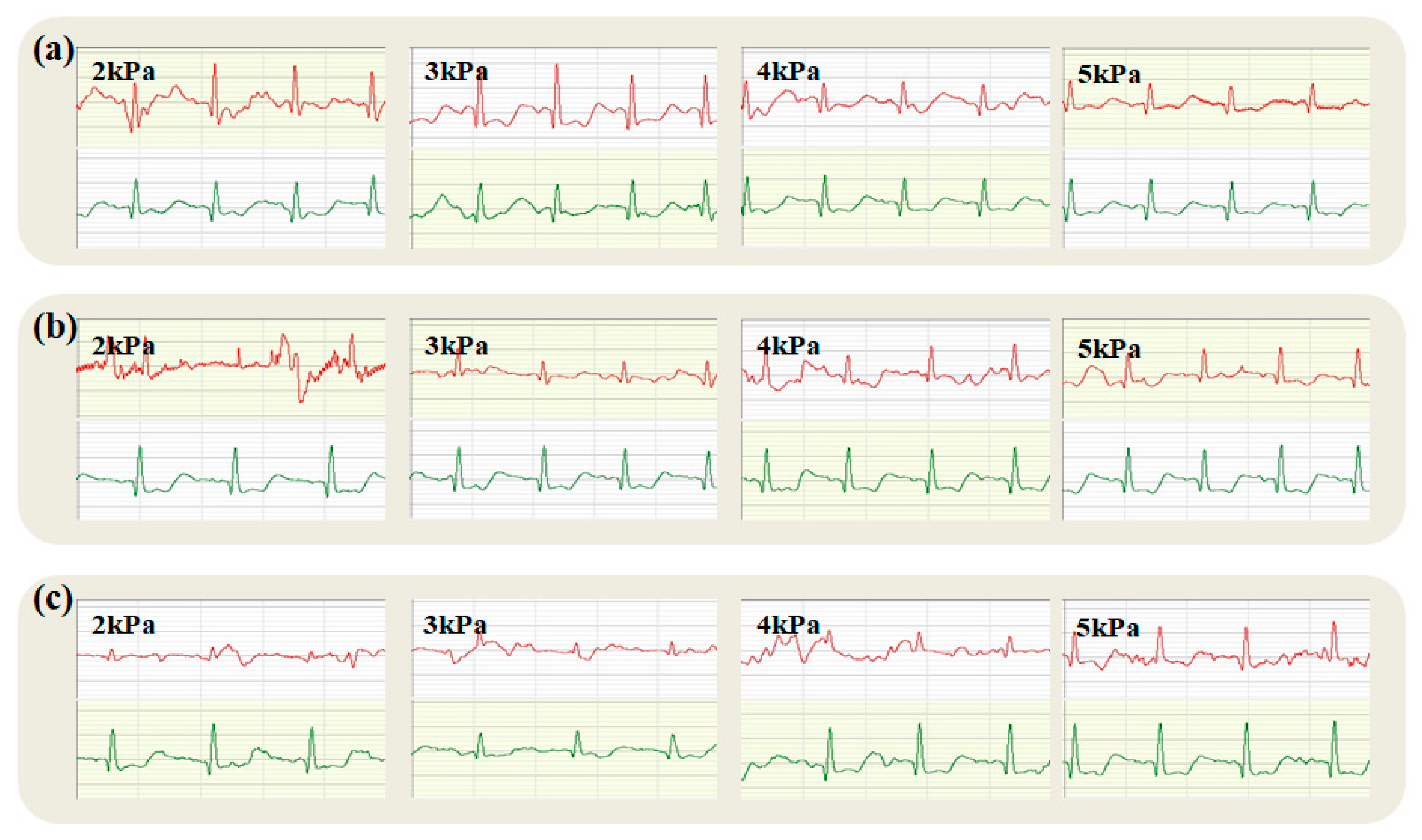
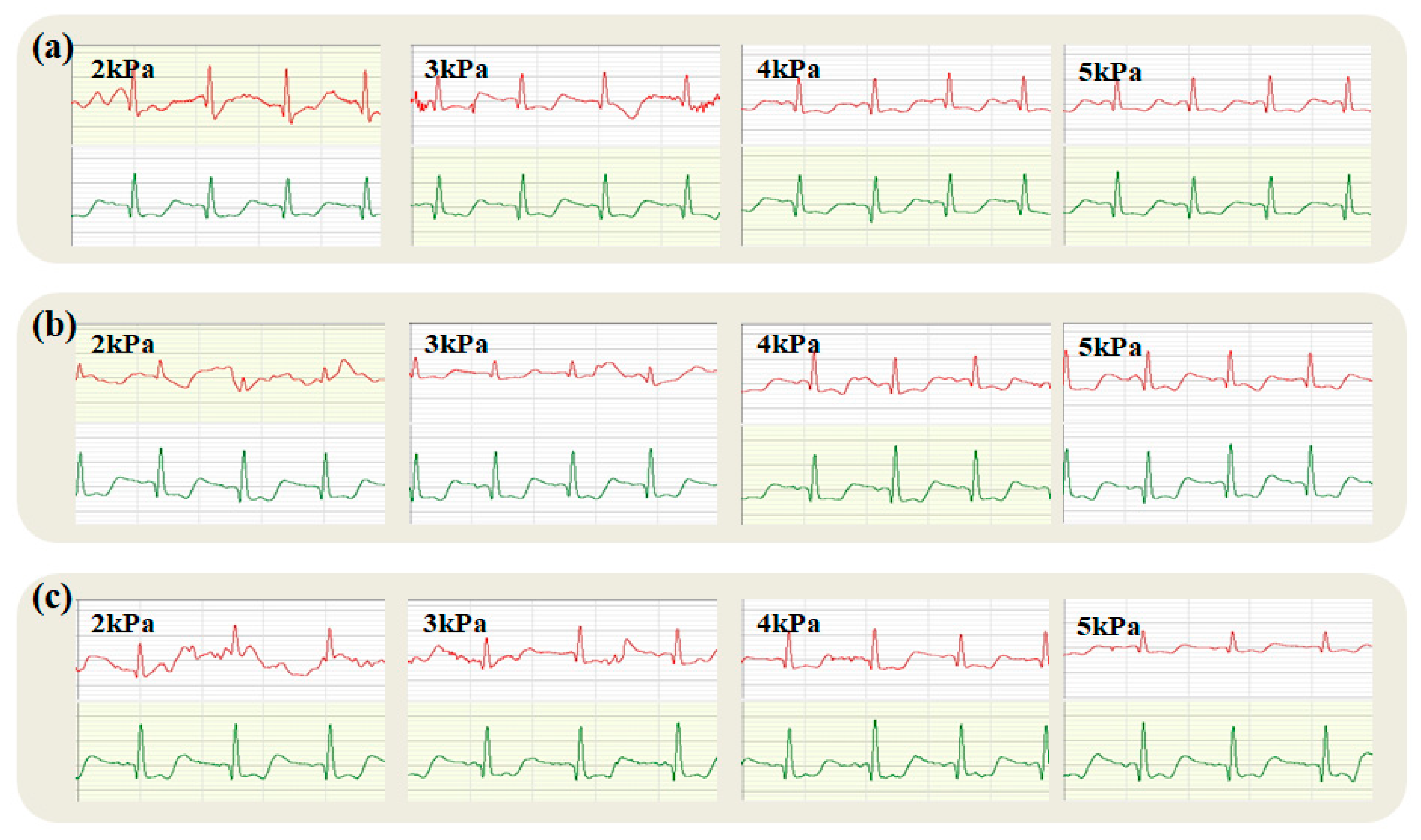

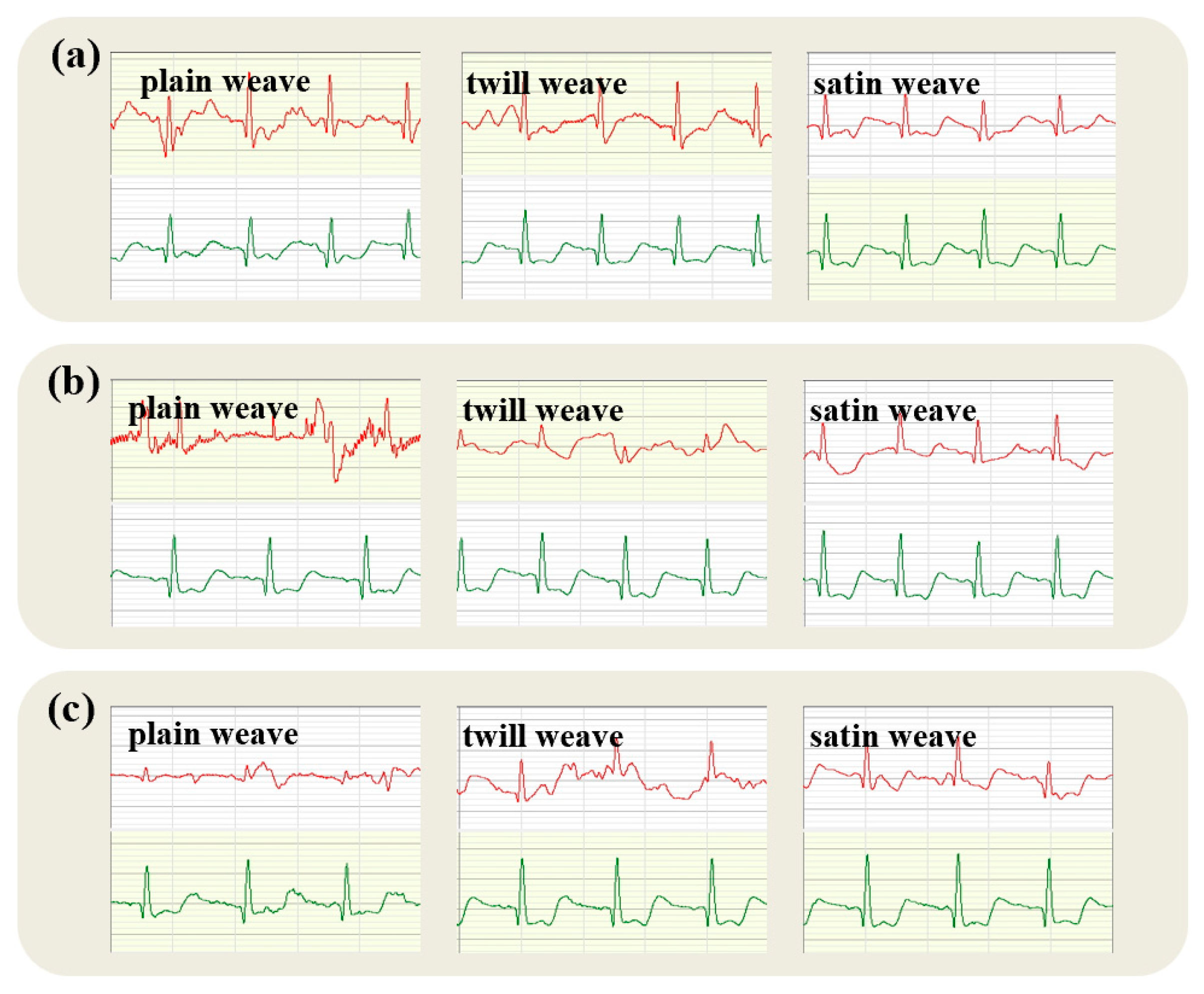
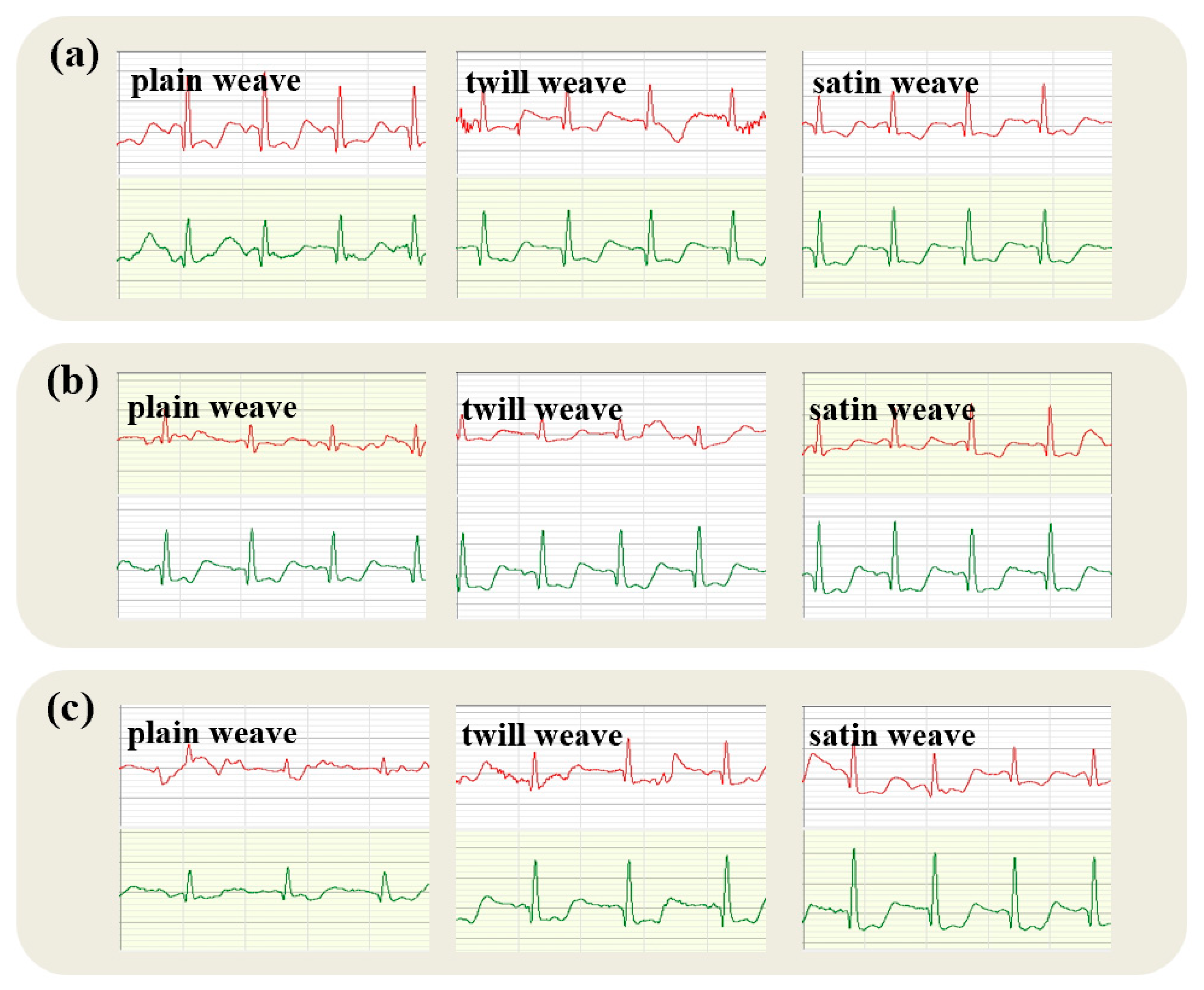
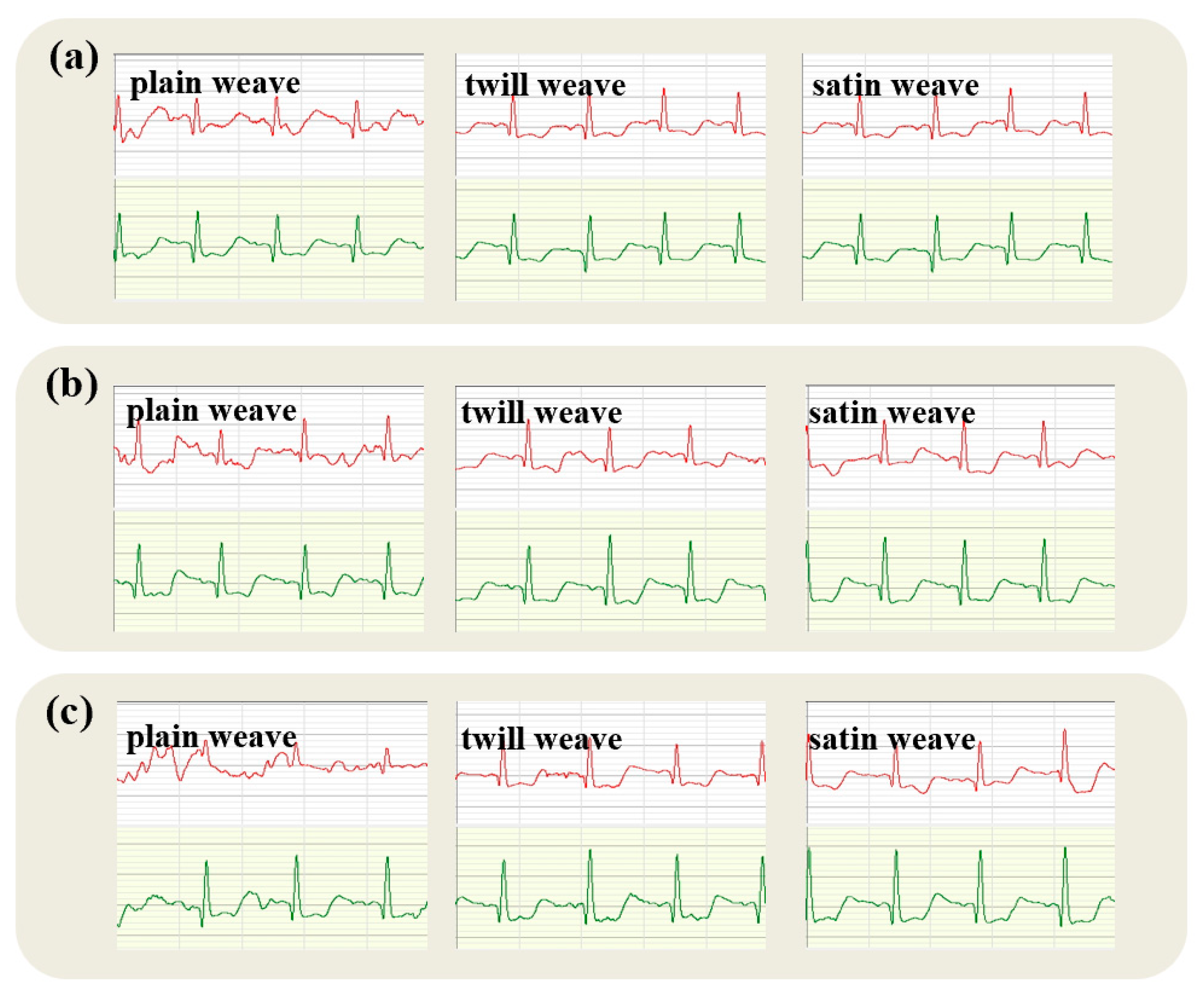
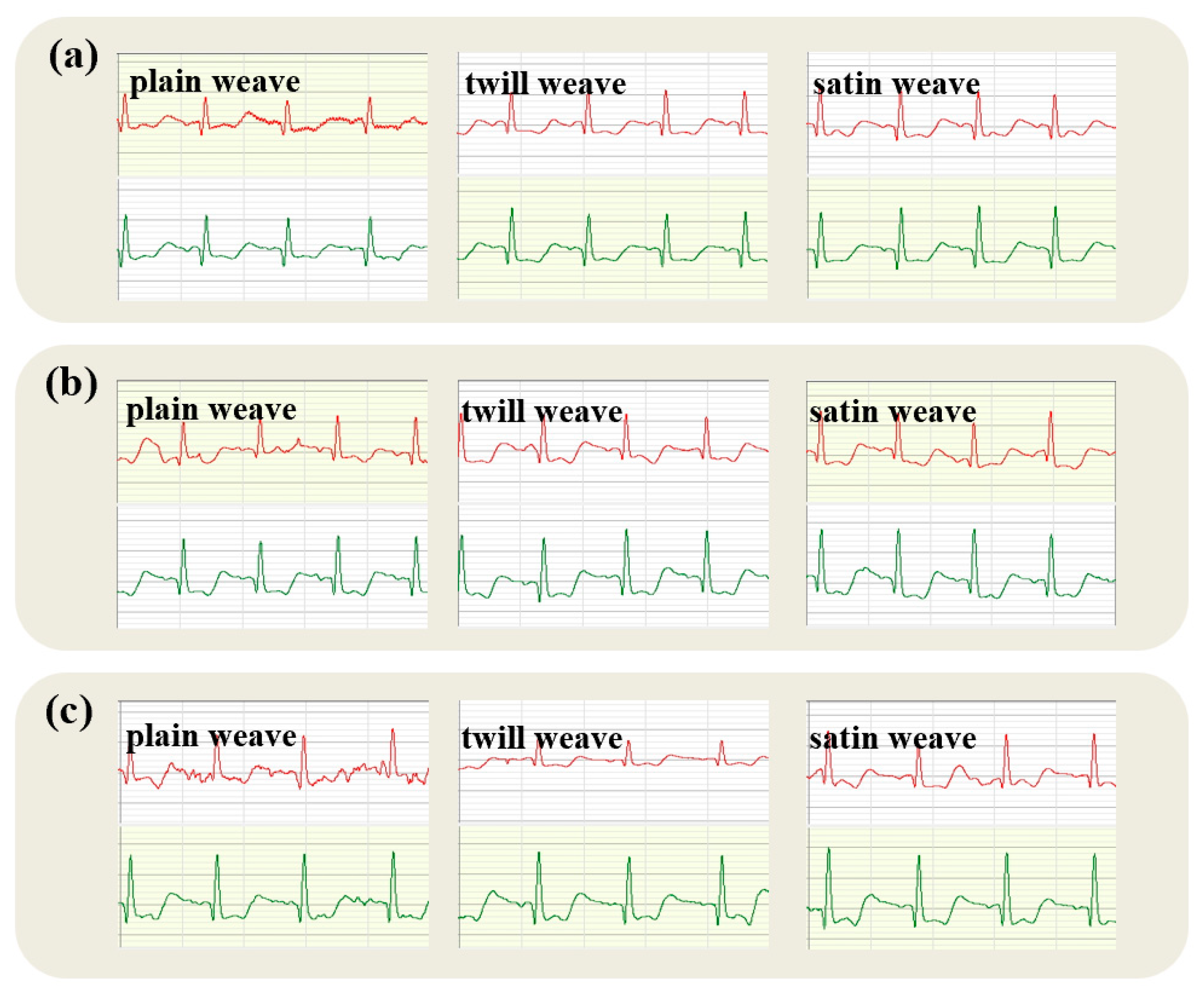
| Parameter | Significance |
|---|---|
| Skin-electrode impedance | High impedance leads to signal attenuation/noise increase (ideal value: ≤2 kΩ at 10 Hz) [10,11] |
| Motion artifact suppression | The ability of the electrode to resist motion interference (critical for wearable ECG) [11,12,13] |
| Long-term stability | The consistency of signal quality over time (especially important for long-term monitoring) [14,15] |
| Biocompatibility | Reducing skin irritation/allergic reactions (ISO 10993 standard) [16,17,18] |
| Baseline drift suppression | Maintaining a stable signal baseline (affected by electrolyte gel/adhesive) [9,13] |
| Signal-to-noise ratio (SNR) | The intensity ratio of the pure signal to noise determines the distinguishability of the waveform. [19,20] |
Disclaimer/Publisher’s Note: The statements, opinions and data contained in all publications are solely those of the individual author(s) and contributor(s) and not of MDPI and/or the editor(s). MDPI and/or the editor(s) disclaim responsibility for any injury to people or property resulting from any ideas, methods, instructions or products referred to in the content. |
© 2025 by the authors. Licensee MDPI, Basel, Switzerland. This article is an open access article distributed under the terms and conditions of the Creative Commons Attribution (CC BY) license (https://creativecommons.org/licenses/by/4.0/).
Share and Cite
Wang, M.; Zhou, J.; Zhang, G. Study on Electrical Characteristics and ECG Signal Acquisition Performance of Fabric Electrodes Based on Organizational Structure and Wearing Pressure. Micromachines 2025, 16, 821. https://doi.org/10.3390/mi16070821
Wang M, Zhou J, Zhang G. Study on Electrical Characteristics and ECG Signal Acquisition Performance of Fabric Electrodes Based on Organizational Structure and Wearing Pressure. Micromachines. 2025; 16(7):821. https://doi.org/10.3390/mi16070821
Chicago/Turabian StyleWang, Ming, Jinli Zhou, and Ge Zhang. 2025. "Study on Electrical Characteristics and ECG Signal Acquisition Performance of Fabric Electrodes Based on Organizational Structure and Wearing Pressure" Micromachines 16, no. 7: 821. https://doi.org/10.3390/mi16070821
APA StyleWang, M., Zhou, J., & Zhang, G. (2025). Study on Electrical Characteristics and ECG Signal Acquisition Performance of Fabric Electrodes Based on Organizational Structure and Wearing Pressure. Micromachines, 16(7), 821. https://doi.org/10.3390/mi16070821





